Circular seating arrangement questions for competitive exams are available here. In the reasoning ability section, the seating arrangement is an important topic. There are various types of seating arrangement questions. Circular Arrangement is a special type of Sitting Arrangement, where objects or persons are placed around a circle either facing the center or facing the direction opposite to the center. The aspirants can expect 5-10 Marks in Prelims Examination and 15-20 Marks in Mains examination. Overall it covers around 20-30 % portion of the Reasoning Ability Section. If you prepare Seating Arrangement topics well, you can boost your score in the Reasoning section. To solve seating arrangement questions, you need to gather the information first. These questions have two types of information: –Direct information: that is mentioned in the statement of the question. This is the information that you will use when you start solving the questions. –Indirect information: After filling in the direct information, you will look for the connection between different parts of the information. These connections form indirect information. Both of these will help you formulate an arrangement. After which, you will be able to answer all subsequent parts of the question.
What is a circular seating arrangement? – In this topic, a question set will be given with some statements. The question may be based on the person facing inside or outside or mixed. You have to connect the clues and find the correct seating arrangement order. Practice more with our Circular seating arrangement questions for bank PO Mains exams pdf to gain experience on all models.
Circular seating arrangement for the competitive exam: FAQ
1) What is a circular seating arrangement?
Ans. Circular Arrangement is a special type of Sitting Arrangement, where objects or persons are placed around a circle either facing the center or facing the direction opposite to the center.
2) What is a circular permutation for example?
Ans. Permutation in a circle is called a circular permutation. If we consider a round table and 3 persons then the number of different sitting arrangements that we can have around the round table is an example of circular permutation.
Direction (1-5): Study the following information carefully and answer the questions given below.
Eight persons- P, Q, R, S, T, U, V and W are sitting around a circular table and facing inside the circle, but not necessarily in the same order.
Q sits second to the left of P. Two persons sit between P and S who sits adjacent to U.R sits third to the right of U and three persons sit between R and T. V sits second to the left of T. Four persons sit between W and V when counted from the left of W.
1) Who among the following person sits to the immediate left of Q?
A.W
B.V
C.The one who sits second to the right of S
D.S
E.The one who sits second to the left of P
2) How many persons sit between P and S when counted from the left of P?
A.Five
B.As many persons sit between Q and S when counted from the left of S
C.One
D.As many persons sit between T and R.
E.None
3) Four of the following five are alike in a certain way as per the given arrangement and hence form a group. Find the one who doesn’t belong to that group.
A.U, P
B.T, V
C.W, U
D.R, P
E.Q, W
4) If W is related to Q and T is related to S in a certain way. Then, P is related to who among the following persons?
A.W
B.R
C.V
D.U
E.None of the above
5) Who among the following pair of persons sit adjacent to V?
A.P and T
B.Q and P
C.Q and R
D.P and U
E.W and Q
Direction (6-10): Study the following information carefully and answer the questions given below.
Eight persons – A, B, C, D, E, F, G, and H are sitting on a circular table facing towards the center, but not necessarily in the same order. The consecutive alphabetically named persons are not sitting adjacent to each other.
Two persons sit between A and C, who faces E. One person sits between A and F. The number of persons sitting between E and F is twice the number of persons sitting between C and H, when counted from the right of both F and C. D sits exactly between B and G, who doesn’t sit adjacent to E.
6) Who among the following person sits second to the left of C?
A.The one who sits immediate right of E
B.G
C.The one who sits third to the right of A
D.H
E.None of these
7) What is the position of F with respect to H?
A.Fourth to the right
B.Immediate left
C.Second to the left
D.Third to the right
E.None of these
8) If all the persons are made to sit in the alphabetical order from A in the clockwise direction, then how many persons remain unchanged in their position, excluding A?
A.One
B.Two
C.Three
D.More than three
E.None
9) Find out the series that follow the same logic.
DG FA BC ___.
A.HD
B.FE
C.HB
D.AG
E.None of these
10) Which of the following statement(s) is/are true with respect to the final arrangement?
I) Neither B nor H sits adjacent to E.
II)More than one person sits between E and G, when counted from both sides.
III) A sits exactly between B and F.
A.Only I
B.Only III
C.Both I and II
D.Both II and III
E.None
Try Seating Arrangement Questions For Online Mock Test
Answers :
Directions (1-5) :
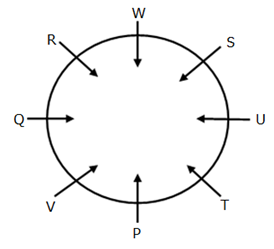
We have,
- Q sits second to the left of P.
- Two persons sit between P and S.
From the above condition, there are two possibilities
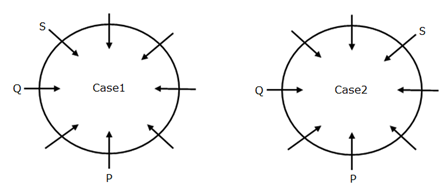
Again we have,
- S sits adjacent to U.
- R sits third to the right of U.
- Three persons sit between R and T.
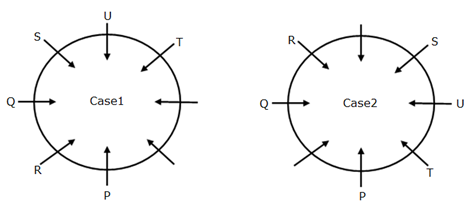
Again we have,
- V sits second to the left of T.
- Four persons sit between W and V when counted from the left of W.
So Case1 gets eliminated. HenceCase2 becomes the final arrangement.
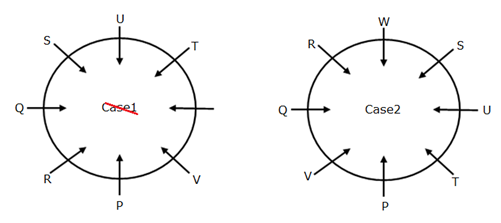
1) Answer: C
2) Answer: B
3) Answer: D (Except d, the first person sits second to the right of the second person)
4) Answer: D
5) Answer: B
Directions (6-10) :
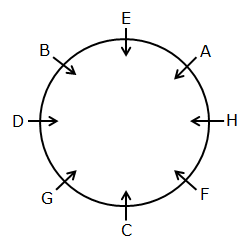
We have,
- Two persons sit between A and C, who faces E.
- One person sits between A and F.
From the above conditions, there are two possibilities.
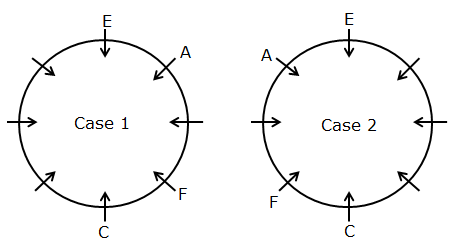
Again we have,
- The number of persons sitting between E and F is twice the number of persons sitting between C and H, when counted from the right of both F and C.
- D sits exactly between B and G, who doesn’t sit adjacent to E.
- The consecutive alphabetically named person doesn’t sit adjacent to each other.
From the above conditions, case 2 gets eliminated. Hence, case 1 shows the final arrangement.
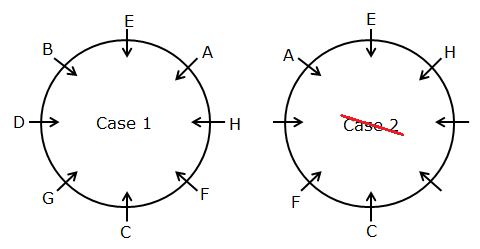
6) Answer: C
7) Answer: B
8) Answer: E
9) Answer: A
10) Answer: D
Direction (11-15): Study the following information carefully and answer the questions given below.
Eight persons R, S, T, U, V, W, X and Y are sitting around a circular table facing the centre but not necessarily in the same order.
R sits second to the right of T. Only Two persons sit between T and U. V sits immediate right of Y who neither sits adjacent to U nor sits second to the right of U. S sits second to the right of V. Only two persons sit between S and W. Both X and S are not immediate neighbours.
11) Who among the following person sits immediate right of X?
A.S
B.The one who sits second to the left of T
C.The one who sits opposite to S
D.V
E.None of these
12) Who among the following person sits opposite to T?
A.R
B.Y
C.The one who sits second to the right of X
D.The one who sits immediate right of U
E.S
13) If W is related to R and V is related to X in a certain way. Then, who among the following person is related to Y?
A.U
B.S
C.T
D.V
E.None of these
14) How many persons sit between V and U, when counted from the right of U?
A.One
B.Two
C.Three
D.More than four
E.No one
15) Which of the following statement(s) is/are true with respect to the final arrangement?
A.Only three persons sit between W and V
B.X sits second to the right of V
C.R sits opposite to T
D.S and U are immediate neighbours
E.R sits immediate left of U
Direction (16-20): Study the following information carefully and answer the questions given below.
Eight people are sitting around a circular table facing towards the center of the table but not necessarily in the same order.
Only two persons sit between P and Q (either from left or right). R sits to the immediate right of Q. S sits second to the left of R. Only three persons sit between S and T. U sits to the immediate left of T. W sits second to the left of V.
16) How many persons sit between S and W when counted from the left of S?
A.One
B.Two
C.Three
D.Four
E.None
17) Who among the following persons are immediate neighbors of W?
A.U, R
B.P, S
C.T, P
D.V, T
E.None of these
18) Four of the following five are alike in a certain way as per the given arrangement and hence form a group. Find the one that doesn’t belong to that group.
A.WP
B.QR
C.TW
D.UV
E.VS
19) Who among the following person sits to the immediate right of V?
A.Q
B.The one who sits opposite to T
C.P
D.The one who sits immediate left of W
E.None of these
20) What is the position of S with respect to R?
A.Third to the right
B.Second to the right
C.Third to the left
D.Second to the left
E.Fourth to the right
Try Seating Arrangement Questions For Online Mock Test
Answers :
Directions (11-15) :
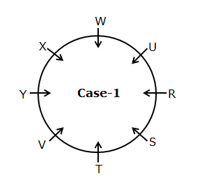
We have,
- R sits second to the right of T.
- Only Two persons sit between T and U.
From the above condition, there are two possibilities
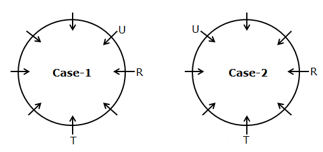
Again we have,
- V sits immediate right of Y who neither sits adjacent to U nor sits second to the right of U.
- S sits second to the right of V
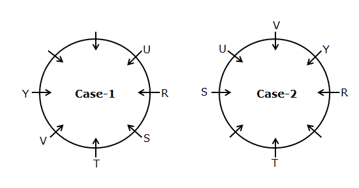
Again we have,
- Only two persons sit between S and W.
- Both X and S are not immediate neighbours.
So Case-2 gets eliminated, hence Case1 shows the final arrangement
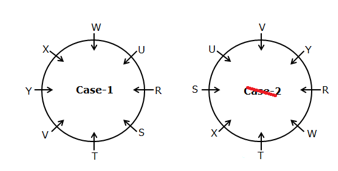
11) Answer: B
12) Answer: D
13) Answer: C
14) Answer: C
15) Answer: E
Directions (16-20) :
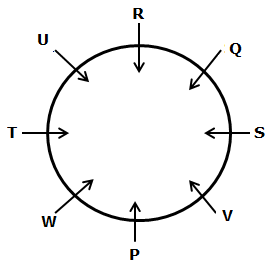
We have,
- Only two persons sit between P and Q (either from left or right).
- R sits to the immediate right of Q.
- S sits second to the left of R
From the above conditions, there are two possibilities
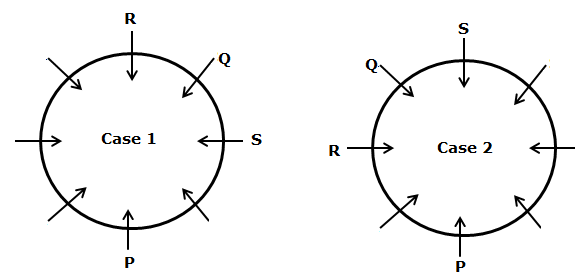
Again we have,
- Only three persons sit between S and T
- U sits to the immediate left of T.
- W sits second to the left of V.
So Case2 gets eliminated. Hence Case1 shows the final arrangement.
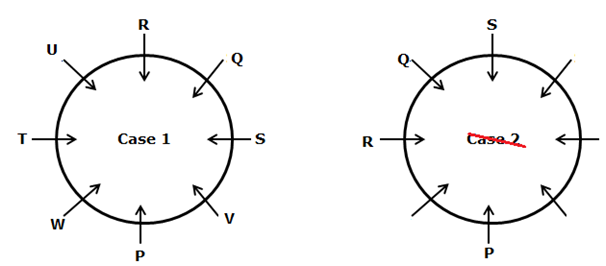
16) Answer: B
17) Answer: C
18) Answer: D (The first person sits immediate left of the second person)
19) Answer: B
20) Answer: D
Direction (21-25): Answer the questions based on the information given below.
Eight persons viz. M, N, O, P, Q, R, S and T are sitting on a circular table such that all of them are facing towards the centre, but not necessarily in the same order.
O sits adjacent to T who faces towards P. Only two persons sit between O and N.S sits to the immediate right of N and second to the right of R. M neither sits adjacent to O nor sits facing towards S.
21) Who among the following person sits second to the left of P?
A.The one who facing Q
B.R
C.The one who sits fifth to the left of T
D.Q
E.None of those given as an option
22) If M is related to O and T is related to N in a certain way, then who among the following person is related to S?
A.Q
B.P
C.R
D.M
E.None of these
23) How many persons sit between R and T when counted from the right of R?
A.As many as between S and N when counted from left of S
B.As many as between M and Q when counted from right of M
C.As many as between S and P when counted from left of P
D.As many as between Q and O when counted from right of O
E.None of these
24) What is the position of P with respect to O?
A.Second to the right
B.Third to the left
C.Third to the right
D.Fourth to the left
E.None of these
25) Who among the following person sits to the immediate right and left of M respectively?
A.PQ
B.SP
C.QP
D.PS
E.None of these
Direction (26-30): Study the following information carefully and answer the below questions
Eight persons- L, M, N, O, P, Q, R, and S are sitting at the circular table facing outside but not necessarily in the same order.
P sits second to the right of R. Two persons are sitting between S and Q. Q sits adjacent to R. M sits third to the right of L. M and P are not immediate neighbors. L sits second to the left of O. The number of persons sitting between N and M is the same as between N and S.
26) Who among the following person sits second to the right of Q?
A.The one who sits second to the left of S
B.O
C.S
D.The one who sits immediate left of M
E.N
27) How many people sit between N and M when counted from the right of N?
A.Two
B.Three
C.One
D.Four
E.No one
28) Which of the following statement is/are false?
I) O and M are sitting adjacent to each other
II) Only one person sits between R and L
III) S sits immediate right of L
A.Only I and III
B.Only III
C.Only I and II
D.Only II
E.All I, II, and III
29) What is the position of P with respect to O?
A.Second to the right
B.Third to the right
C.Second to the left
D.Third to the left
E.Immediate right
30) Four of the five among the following are similar in such a way to form a group, who among the following doesn’t belong to the group?
A.OM
B.QR
C.NP
D.LS
E.SQ
Try Seating Arrangement Questions For Online Mock Test
Answers :
Directions (21-25) :
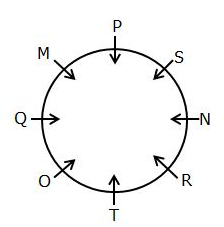
1. O sits adjacent to T who faces towards P. Only two persons sit between O and N.
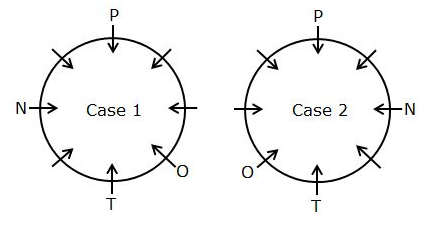
2. S sits to the immediate right of N and second to the right of R. M neither sits adjacent to O nor sits facing towards S. hence, case 1 gets eliminated.
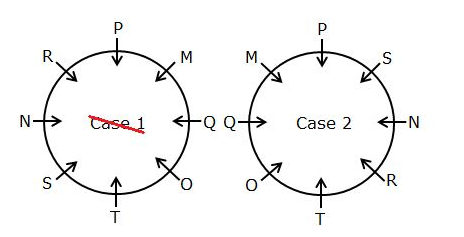
21) Answer: A
22) Answer: C
23) Answer: D
24) Answer: B
25) Answer: C
Directions (26-30) :

We have,
- P sits second to the right of R.
- Two persons are sitting between S and Q.
- Q sits adjacent to R.
From the above condition, there are three possibilities.

Again we have,
- M sits third to the right of L.
- M and P are not immediate neighbors.

Again we have,
- L sits second to the left of O.
From the above condition, case2 gets eliminated.

Again we have,
- The number of persons sitting between N and M is the same as between N and S.
From the above condition, case2a gets eliminated. case1 shows the final arrangement.
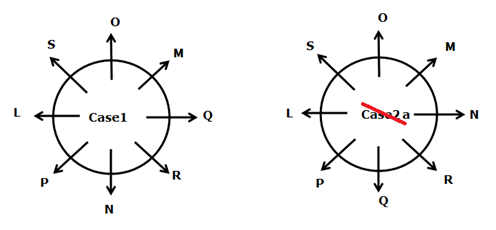
26) Answer: E
27) Answer: D
28) Answer: D
29) Answer: D
30) Answer: E
Direction (31-35): Study the following information carefully and answer the below questions.
Eight persons- A, B, C, D, E, F, G, and H are sitting at the circular table at an equidistant distance from each other facing the center but not necessarily in the same order.
Only two persons are sitting between C and H. F sits immediate left of G. B and C are not immediate neighbors. E sits second to the right of C. The number of persons sitting between D and A when counting from the left of D is the same as between B and F when counting from the right of B. D sits neither adjacent to C nor H.
31) If all the persons are sitting in alphabetical order starting from A in clockwise order how many persons remain unchanged in their position (excluding A)?
A.2
B.3
C.1
D.No one
E.4
32) If E is related to C and G is related to H in a certain way. Then who among the following is related to B?
A.F
B.The one who sits opposite to A
C.D
D.The one who sits second to the left of G
E.None of the above
33) How many persons are sitting between A and H?
A.One
B.Two
C.Three
D.Four
E.Either b or d
34) What is the position of D with respect to F?
A.Second to the left
B.Second to the Right
C.Third to the left
D.Fourth to the right
E.Immediate left
35) Who among the following person sits third to the right of C?
A.H
B.A
C.the one who sits immediate left of B
D.the one who sits third to the right of E
E.None of the above
Direction (36-40): Answer the question based on the information given below.
Eight friends viz. P, Q, R, S, T, U, V and W are sitting in a circular table such that all of them are facing towards the center, but not necessarily in the same order. The consecutive alphabetically named person doesn’t sit adjacent to each other.
Only two persons sit between W and U who sits to the immediate right of Q.R sits second to the left of T who doesn’t sit adjacent to W.More than two persons sit between V and S (both on left and right side of V). P doesn’t sit adjacent to S.
36) Who amongst the following sits exactly between U and V when counted from left of U?
A.S
B.W
C.Q
D.T
E.P
37) How many people are seated between P and R when counted clockwise from P?
A.Two
B.Four
C.None
D.One
E.Three
38) Four of the following five are alike in a certain way, based on their arrangement and hence form a group. Find the one that doesn’t belong to that group.
A.WT
B.US
C.VU
D.SP
E.PT
39) Who among the following person sits third to the right of P?
A.R
B.Q
C.U
D.V
E.S
40) Who among the following person sits opposite to V?
A.T
B.S
C.W
D.R
E.Q
Try Seating Arrangement Questions For Online Mock Test
Answers :
Directions (31-35) :
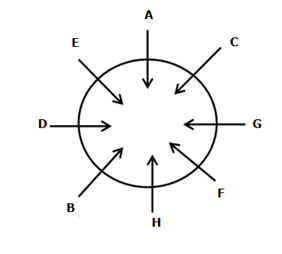
Only two persons are sitting between C and H.
E sits second to the right of C.
From the above condition, there are two possibilities.
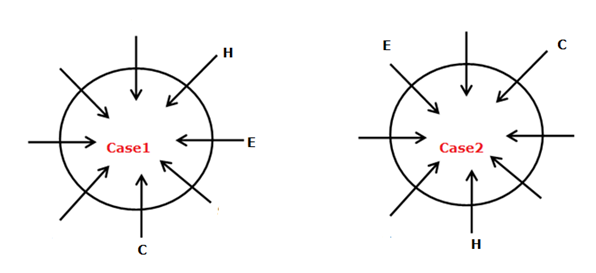
D sits neither adjacent to C nor H.
From the above condition, there are three possibilities.

F sits immediate left of G.
B and C are not immediate neighbors.
From the above conditions, case 1 gets eliminated.

The number of persons sitting between D and A when counting from left of D is the same as betweenB and F when counting from right of B.
From the above condition, case1a gets eliminated. case2 shows the final arrangement.
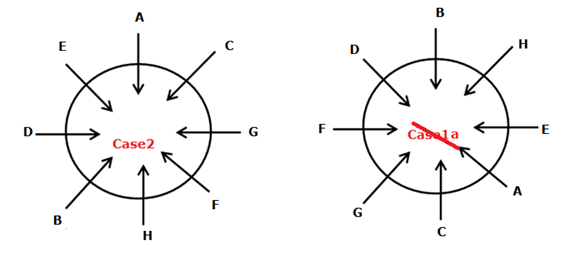
31) Answer: D
32) Answer: A
33) Answer: C
34) Answer: C
35) Answer: C
Directions (36-40) :
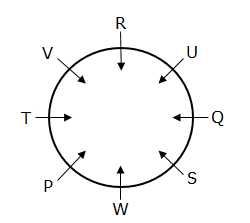
- Only two persons sit between W and U who sits to the immediate right of Q. R sits second to the left of T who doesn’t sit adjacent to W.
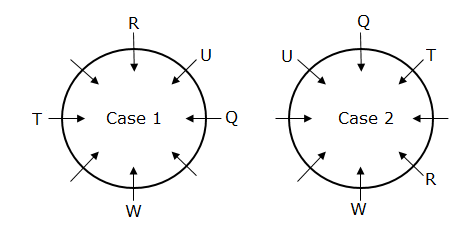
- More than two persons sit between V and S (both on the left and right side of V). P doesn’t sit adjacent to S. Hence, case 2 gets eliminated.
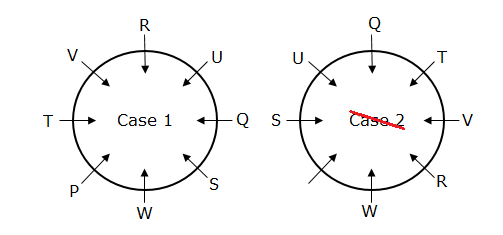
36) Answer: B
37) Answer: A
38) Answer: E
39) Answer: B
40) Answer: B





